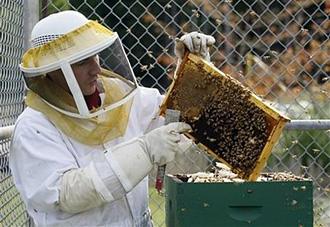
|  |  |  Editorials | Environmental | November 2008 Editorials | Environmental | November 2008  
Green US Prisons Farm, Recycle to Save Energy, Money
 Phuong Le - Associated Press Phuong Le - Associated Press
go to original


| | Daniel Travatte, 36, suits up to check on the Italian honey bees he cares for at the Cedar Creek Corrections Center in rural southwest, Wash. on Friday, Oct. 17, 2008. The bees are part of a program to help the prison be more environmentally green. (AP/John Froschauer) | | |
Of all the things convicted murderer Robert Knowles has been called during his 13 years behind bars, recycler hasn't been one of them.

But there he was one morning, pitchfork in hand, composting food scraps from the main chow line and coffee grounds from prison headquarters — doing his part to "green" the prison.

"It's nice to be out in the elements," said Knowles, 42, stirring dark, rich compost that will amend the soil at the small farm where he and fellow inmates of the Cedar Creek Corrections Center grew 8,000 pounds of organic vegetables this year.

Inmates of the minimum-security facility, 25 miles from Olympia, the state capital, raise bees, grow organic tomatoes and lettuce, compost 100 percent of food waste and even recycle shoe scraps that are made into playground turf.

"It reduces cost, reduces our damaging impact on the environment, engages inmates as students," said Eldon Vail, secretary of the Washington Department of Corrections, which oversees 15 prisons and 18,000 offenders. "It's good security."

As around-the-clock operations, prisons are voracious resource hogs, and administrators are under increasing pressure to reduce waste and conserve energy and water.

In 2007, states spent more than $49 billion to feed, house, clothe, treat and supervise 2.3 million offenders, the Pew Center on the States reported this year.

As the prison population has grown this decade, up 76 percent from 1.3 million in 2000, the number of prisons and jails has risen with it. The latest U.S. Bureau of Justice data show 1,821 facilities in 2005, up from 1,668 in 2000.

To keep costs down, the Indiana Department of Corrections installed water boilers that run on waste wood chips, and built a wind turbine at one prison that generates about 10 kilowatts an hour and saves $2,280 a year.

At Ironwood State Prison in Blythe, Calif., 6,200 solar panels send energy back to the grid, enough to power 4,100 homes a year. The prison was trying to meet an executive order requiring state agencies to reduce energy use by 20 percent by 2015, said a spokeswoman, Lt. Sue Smith.

North Carolina's Department of Corrections switched to chemical-free cleaners and vegetable-based inks. This summer, because of a water shortage, inmates converted 50-gallon pickle barrels into small cisterns that capture rainwater.

Under a state mandate to reduce energy use, the Oregon Department of Corrections replaced old appliances with energy-efficient ones, installed solar water heaters and used a geothermal well to heat water. It also modified washing machines so they could reuse rinse-water to wash about a million pounds of clothes a month.

At Eastern Oregon Correctional Institution in Pendleton, Ore., inmates recycle scraps from old prison blues to make diaper bags for women's shelters and dog beds for animal shelters.

"We try to model prosocial behavior," said Vern Rowan, business manager for the Oregon Department of Corrections. Being sustainable "is something that everybody should be doing, regardless of where they're at."

Cedar Creek, in the heart of a forest, feels more like an outdoor retreat than institutional lockup.

Most of the 400 inmates are in a work program, and put in between six and eight hours a day.

The responsibility of caring for the prison's three hives of Italian honey bees falls mostly to Daniel Travatte, 36, a soft-spoken former drug addict who is serving 10 years for attempted armed robbery.

Under the supervision of prison counselor Vicki Briggs, Travatte has learned to harvest honey — which inmates occasionally eat with breakfast biscuits — and use beeswax to make lotions. He's become an expert on their habits.

"I'm trying to change myself," said Travatte. "A lot of people go through prison with no intention of changing. I love working with the bees. It keeps me busy. I have a lot of responsibility to take care of."

While there isn't scientific evidence that such activities are helping inmates, Nalini Nadkarni, an environmental studies professor at Evergreen State College in Olympia, Wash., notes anecdotal evidence that it's working.

"They were stimulating their minds and having conversations that were different than 'How much more time we have left'?" said Nadkarni.

One inmate went beyond conversations, enrolling in a doctoral program when he got out and co-authoring a research paper with Nadkarni on a moss-growing project she started to help reduce the impact of wild moss harvesting on forests.

While Cedar Creek went green out of economic necessity — it had to conserve because it didn't have the wastewater capacity to expand four years ago — it is now embracing other benefits, said Dan Pacholke, a state prison administrator who helped implement many of the practices.

Cedar Creek uses 250,000 fewer gallons of water a year, saves $6,000 to $8,400 annually on garbage bills and avoided a $1.4 million sewage treatment plant upgrade.

A large "Con-Post" marks the prison's composting station, made of recycled concrete blocks and reclaimed wood, where Knowles spends about six hours a day, making sure the compost gets enough heat, moisture and air to break down food scraps.

"They trust me to do all this with no supervision," said Knowles, who is serving time for the hit-and-run death of an off-duty police officer.

"I like growing the vegetables," Knowles said. "My mom had a garden. I can see having my own garden." |

 |
|  |



